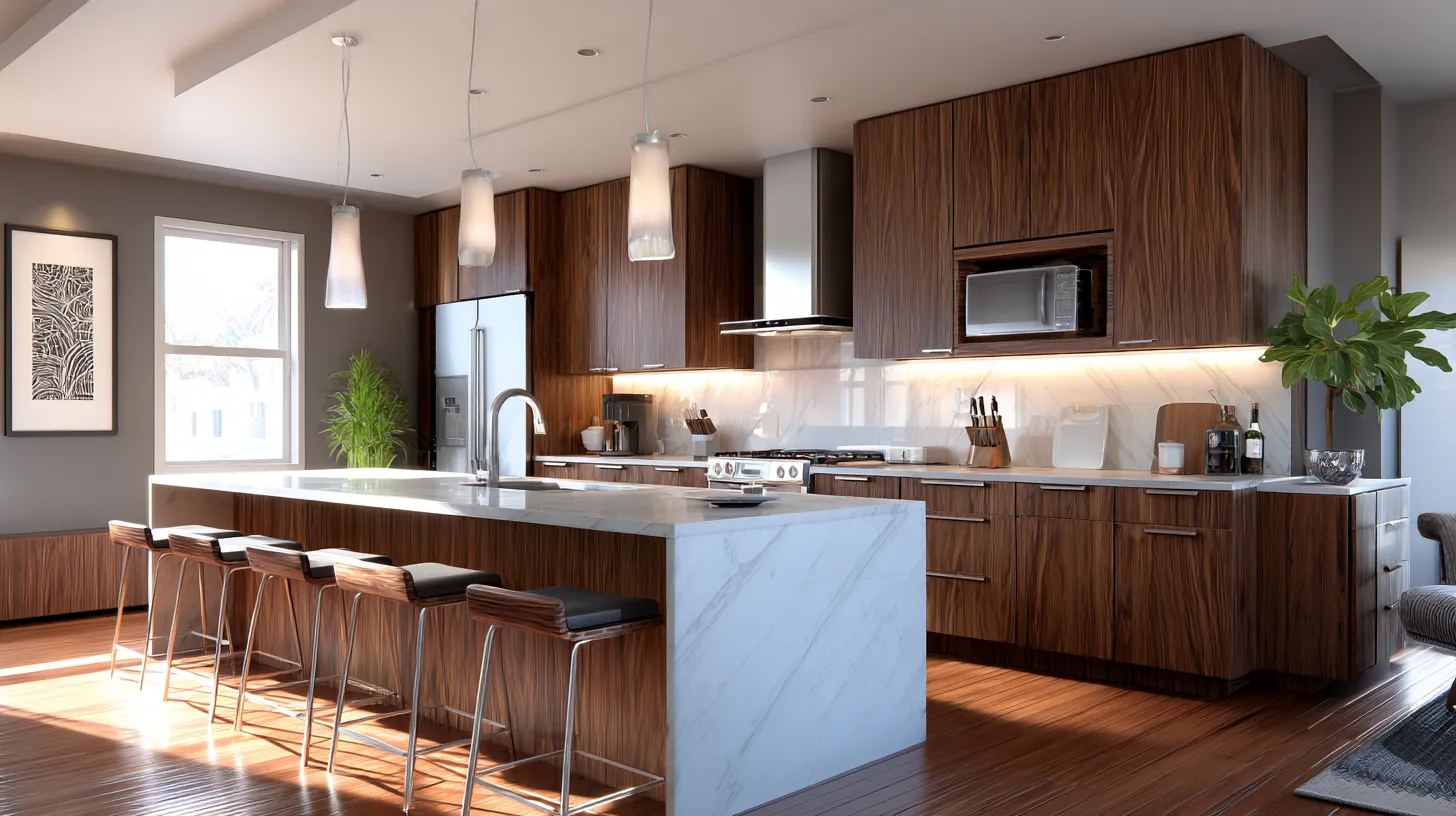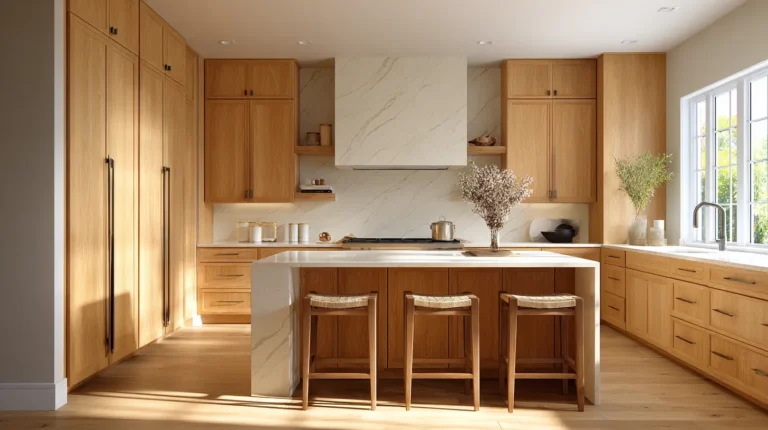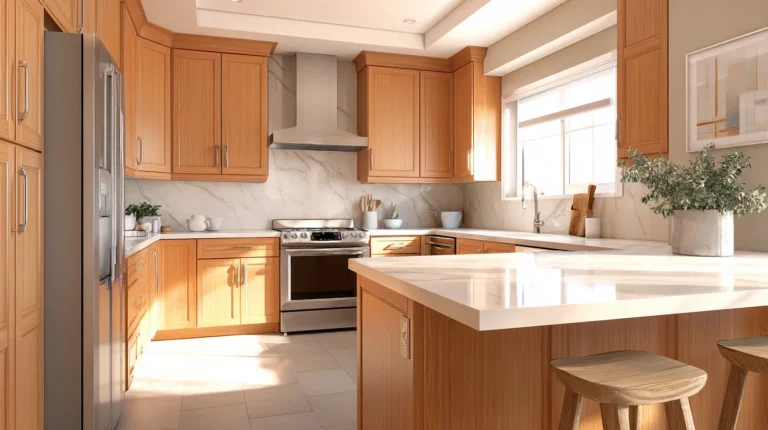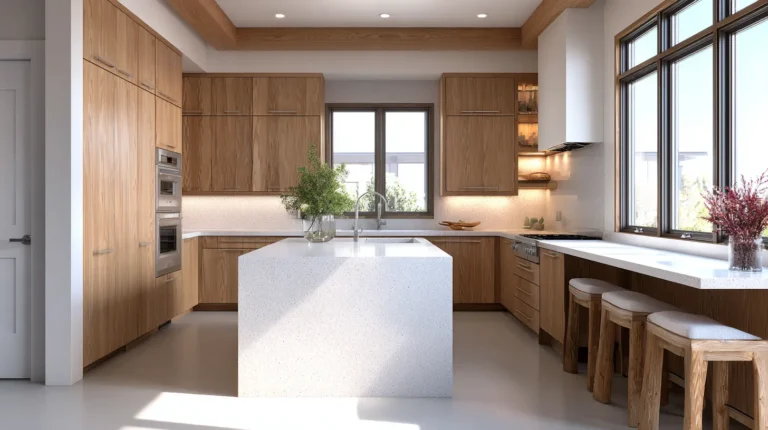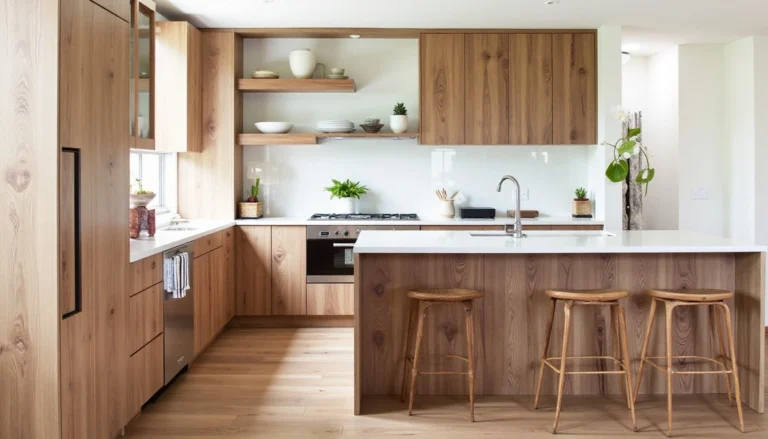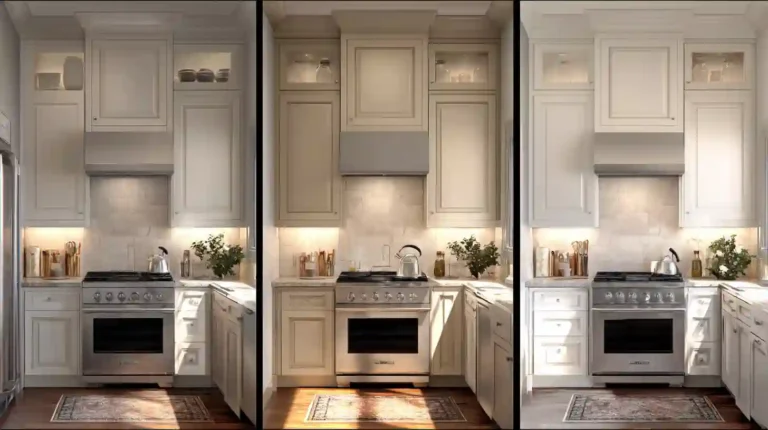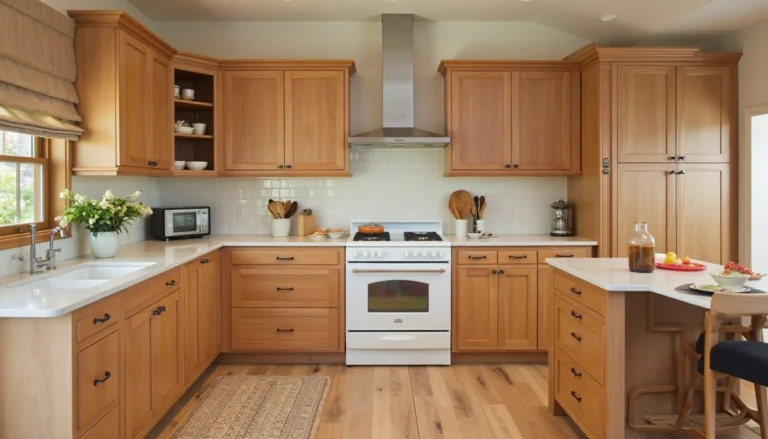How to Pick the Perfect Walnut Cabinets for Your Kitchen
I was elbow deep in paint samples last Tuesday, my fifth trip to Home Depot that week, don’t ask, when my neighbor Linda leaned over my fence and said, Girl, you talk about walnut cabinets like they’re your soulmate. She’s not wrong. True story. I once stained my kitchen the wrong gray, and it looked like a rainy parking lot. Ugh. That’s when I learned walnut is different, it’s rich, warm, forgiving in the way only natural wood can be, and it makes a regular old kitchen feel like it belongs in one of those dreamy Pinterest boards (without me needing a billionaire’s budget
Walnut cabinets are premium hardwood cabinetry known for rich brown tones and distinctive grain, offering long-term durability, a high-end look, and strong resale appeal; the trade-offs are a higher upfront cost, gentle-care cleaning, and natural aging over time in a sunny kitchen
What to know about walnut cabinets before you buy
I’ll admit: when I first fell in love with walnut cabinets, it wasn’t a logical decision. It was a feeling. That deep, chocolatey grain just looked like home, cozy, warm, lived-in. But here’s the thing nobody told me until I learned the hard way. Walnut is gorgeous, yes, but it has quirks.
Why homeowners love walnut cabinets. look, feel, resale
-
The look. Rich brown tones with swirls and ribbons of grain that feel one-of-a-kind. Every door looks slightly different, which is the charm.
-
The feel. Walnut ages gracefully, softening into honey tones over the years like your favorite leather boots breaking in.
-
The resale factor. Buyers notice walnut. Realtors will casually throw in solid walnut cabinets during showings, and it usually turns heads.
The real downsides of walnut cabinets are cost, care, and UV light
-
Pricey upfront. Walnut usually costs more than oak or maple. Think champagne taste on a mid-shelf budget.
-
Needs gentle care. Wipe with mild soap and water. Harsh cleaners can strip the finish. Ask me how I know I once cleaned a door with the wrong spray and cried over the streaks.
-
Sunlight issues. Walnut lightens over time. That rich espresso tone. Leave it in direct sun, and it drifts toward golden brown. Beautiful, but maybe not what you expected
Types of walnut cabinets and how they differ
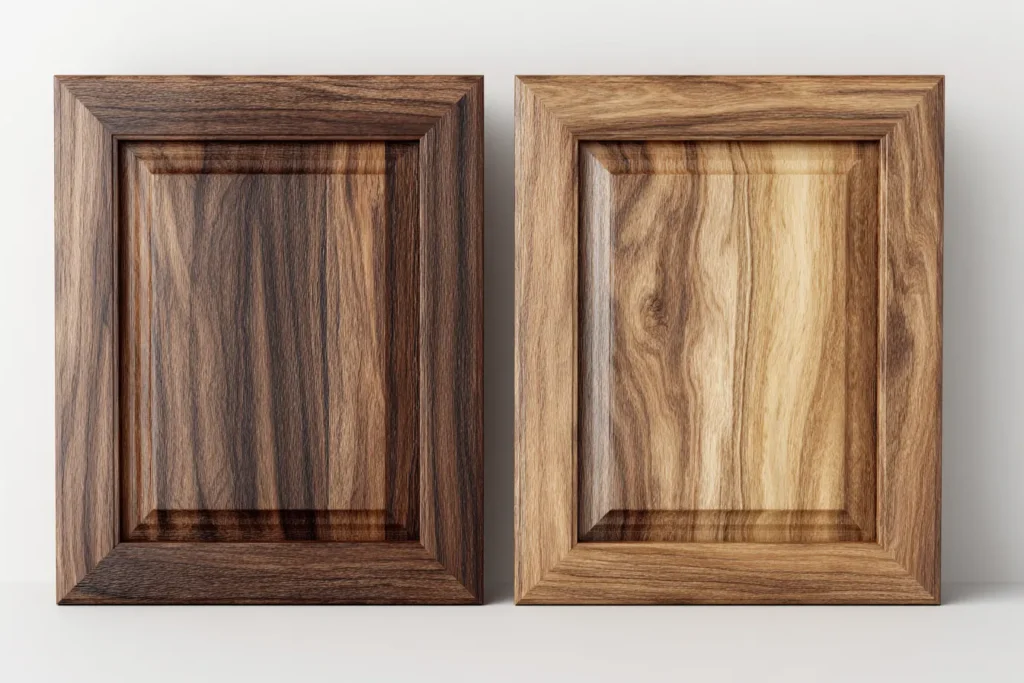
When I first heard there were types of walnut, I laughed. Wood is wood, right? Wrong. Rookie mistake. Turns out, not all walnut cabinets are created equal. The type you choose changes the color, grain, and even how fancy your kitchen feels.
American black walnut vs European walnut for cabinets
-
American black walnut. Deep chocolate to purplish-brown tones, with bold grain swirls. This is the showstopper most U.S. homeowners picture when they say walnut.
-
European walnut. Softer brown with lighter streaks, more subtle, more “classic farmhouse kitchen vibes. My husband calls it the latte version of walnut.
-
What does it mean for you? American reads dramatic and modern; European feels gentler and blends more easily with rustic or transitional styles.
Claro walnut. dramatic grain for statement cabinets
If walnut had a diva cousin, it’s Claro. Think wide, wavy patterns with rich contrasts. Claro often shows up in high-end custom kitchens or islands where you want that bam focal point. Gorgeous, yes, but also the most expensive option. If I win the lottery, Claro’s going in my dream kitchen.
When to choose veneer vs solid walnut cabinet doors
-
Solid walnut. Luxurious, heavy, and built to last decades, but prepare your wallet.
-
Walnut veneer. A thin slice of walnut over plywood or MDF. Looks nearly identical once finished, but at a fraction of the cost. Perfect if you want the look without refinancing your house. Been there.
How much do walnut cabinets cost in a real kitchen

Here’s the part that made me gulp coffee a little too fast. Walnut cabinets aren’t cheap. When I priced them out for my own kitchen, the numbers looked more like a new car than a weekend project. But, and this is important, there are ways to get the look without draining your kid’s college fund.
Custom, semi-custom, and stock price ranges
-
Custom walnut cabinets. $900 to $2,500 per linear foot. Yep, it’s a splurge. But you get hand-picked slabs, exact sizing, and heirloom quality. (If your kitchen is your forever home, this is the long-haul option.)
-
Semi-custom. $300 to $1,100 per linear foot. A balance of design flexibility and lower cost. Think of it as ordering off a menu, but with extra toppings.
-
Stock/RTA ready-to-assemble. As low as $150 per linear foot. These usually use walnut veneer or walnut-colored finishes, but still give you that warm, rich vibe without the heart attack price tag.
Ways to get the walnut look for less. stain, veneer, RTA
-
Stain on another wood. Maple or birch stained in walnut shades. Not identical, but close enough that guests won’t notice unless they moonlight as lumber graders.
-
Walnut veneer doors. Thin slices of walnut layered over a budget-friendly core. You get the real grain, just not the solid heft or cost.
-
Mix-and-match design. Splurge on walnut for an island or uppers, then use painted cabinets elsewhere. Looks intentional, saves thousands.
Confession: I once got quoted $18,000 for a full walnut, then scaled back to a walnut island with white lowers, and my husband finally unclenched his jaw.
Design ideas. pairing walnut cabinets with floors, counters, and hardware

When I first installed a walnut sample door in my kitchen, I stood there staring at it like a lost puppy. Walnut is stunning, but it needs friends, the right floors, counters, and hardware to really sing. Otherwise, it can feel heavy or dated.
Modern kitchens with walnut cabinets, light counters, matte black hardware
-
Counters. Crisp white quartz or pale gray stone keeps walnut from feeling too dark. I once tried pairing it with beige granite, nope, it looked like 1997 called and wanted its kitchen back.
-
Floors. Light oak or whitewashed planks create contrast and brighten the whole room.
-
Hardware. Matte black pulls = instant modern edge. Brass also works if you like warmth-on-warmth, but black feels sharp and intentional.
Two-tone kitchens that flatter walnut cabinets
-
Walnut + white. Classic combo. Walnut lowers + white uppers = light, airy, grounded at the same time.
-
Walnut + navy. Bold but beautiful. Navy lowers or an island with walnut uppers gives depth without being too heavy.
-
Walnut + concrete/industrial. If you’re into loft vibes, pair walnut with steel accents and polished concrete. My husband vetoed this for our suburban ranch, but I still dream about it.
Pro tip: before committing, tape sample boards together and leave them on your counter for a week. Daylight, lamplight, coffee spills, see how walnut plays with real life before swiping your card.
Caring for walnut cabinets so they age beautifully

Here’s the thing I wish someone had told me before I learned the hard way: walnut is like that friend who looks amazing but secretly has a whole skincare routine. Gorgeous? Yes. Effortless? Not quite. Ask me about the time I cleaned a cabinet door with a generic spray and ended up with streaks that looked like toddler fingerprints… except it was me. Ugh.
Weekly cleaning routine that actually works
-
Mild and simple. A squirt of plain dish soap in warm water and a soft rag. That’s it.
-
No lounging water. Wipe dry right away, standing water leaves little ghost spots on walnut faster than you can say Where’s the paper towel?”
-
A little love oil. Every couple of months, I rub in a dab of food-safe mineral oil. The $9 bottle from Target lasts forever. It makes the grain pop and covers tiny scratches.
Keeping sunlight from stealing the color
-
Shade it out. If you’ve got a sunny kitchen, curtains or bamboo shades are your new BFFs. My neighbor Linda didn’t believe me… until her island turned from espresso-dark to golden-brown in a single summer.
-
Finish with protection. Some cabinet shops offer UV-resistant topcoats. Totally worth asking about if you’re going walnut-heavy.
-
Mix and match smartly. If your kitchen gets blasted by afternoon sun, maybe keep walnut on the lowers or island and use paint or lighter wood up top. I did this after realizing half my uppers were basically tanning faster than I was.
Are walnut cabinets right for your home? quick quiz + checklist

I’ll be honest: walnut cabinets are dreamy, but they’re not for everyone. When I was debating, I literally made a pro/con list on the back of a grocery receipt (somewhere between buy milk and “return library books. So here’s your shortcut version, a little quiz to help you figure it out.
Who should pick walnut cabinets?
-
You swoon over rich, natural wood grain and want every cabinet to feel unique.
-
You’re okay investing more upfront for beauty and resale value.
-
You don’t mind a bit of upkeep (gentle cleaning, the occasional polish
-
You like the idea of walnut aging gracefully, softening from dark chocolate to warm honey tones.
Great alternatives if you love the look but not the price
-
Stained maple or birch. Affordable woods that take walnut-colored stain beautifully.
-
Walnut veneer doors. Real walnut on the surface, budget-friendly underneath.
-
Two-tone kitchens. Make walnut the star on an island or lower cabinets, then use painted uppers to save money and brighten the room
-
RTA options: Ready-to-assemble kits online often have walnut-look finishes for a fraction of custom prices.
Quick gut-check.
-
If you’re dreaming of a forever kitchen, walnut could be worth it.
-
If your budget is tight or you’ve got kids + dogs + chaos, maybe try a walnut look-alike for now.
And hey, no shame, I did a mix of real walnut and painted white, and even my mother-in-law thought it was custom high-end. Win!
Final thoughts on walnut cabinets
Here’s the thing nobody told me when I first started my kitchen reno journey. Cabinets are emotional. They’re not just wood boxes with doors. They set the whole mood of your space, the backdrop for late-night snacks, Sunday pancakes, and all the messy little moments in between.
Walnut cabinets? They bring warmth, richness, and that wow factor that makes people pause when they walk in. But they also ask for a little more from you, more budget, more care, more patience with sunlight.
My honest take. If you’re planning to stay in your home for years and you want a kitchen that feels timeless and personal, walnut is worth it. If not, don’t stress, there are so many walnut-inspired alternatives that still give you the cozy look without the price tag.
Either way, your kitchen should feel like you, with fingerprints, coffee stains, happy chaos, and all. And if walnut makes your heart beat faster like it did mine, well, go for it. One cabinet at a time
Frequently asked questions about walnut cabinets
Do walnut cabinets fade over time?
Yes, walnut naturally lightens when exposed to sunlight. That deep espresso tone can mellow into warm honey or golden brown. It’s not a flaw, just part of the wood’s personality. If you want to slow it down, use UV-protective finishes or keep curtains handy on those sunny windows.
Are walnut cabinets more expensive than other woods?
Usually, yes. Solid walnut tends to cost more than oak or maple, think $900 to $2,500 per linear foot for custom builds. Veneer or walnut-stained alternatives can give you the look at a fraction of the cost.
How durable are walnut cabinets?
Walnut is a strong hardwood, but it’s slightly softer than maple or oak. Translation. It’ll hold up for decades if cared for, but you might see the occasional ding if kids or cast-iron pans get wild. Ask me how I know
Is walnut a good wood for cabinets?
Yes, walnut is a fantastic wood for cabinets if you love warmth and character. It’s durable, unique in grain, and adds serious resale appeal. The only catch? It’s pricier and needs gentle care. Worth it, in my book.
Are walnut cabinets still in style?
Oh yes. Walnut is timeless. Some years it shows up in glossy modern kitchens, other years in cozy rustic ones, but it never fully goes out. It’s like denim: always around, just styled differently.
What kitchen cabinet color is outdated?
The big one right now? Orangey oak from the 1990s. My first kitchen had it. I called it pumpkin spice gone wrong. Other outdated looks are high-gloss cherry and anything too matchy-matchy. Walnut, on the other hand, feels rich and current.
Are walnut cabinets more expensive than oak?
Yep, generally. Oak is budget-friendly and sturdy, while walnut runs higher because of its rarity and rich grain. Think of oak as reliable sneakers and walnut as designer boots. Both work, but one costs more to show off

